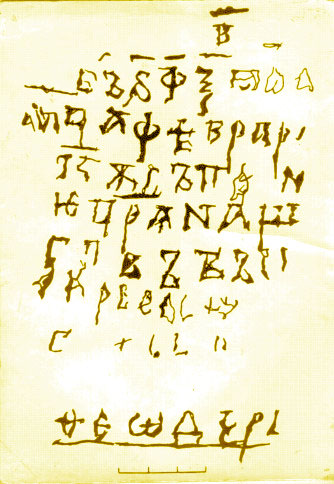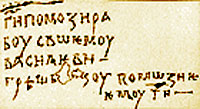ua. ru. en.
Museum ST. SOPHIA CATHEDRAL
Historical information
Plan of museum
ST. SOPHIA CATHEDRAL
Narthex
Architecture and murals
- Plan, Ground floor
- Mosaics
- Frescos
- Graffiti
- other details
Sarcophagus of Yaroslav the Wise
North cloister
Towers
Lofts
- Plan, First floor
ARCHITECTURAL MONUMENTS OF THE 18TH CENTURY
Bell Tower
Seminary
Cells of the Cathedral Elders
Metropolitan's Residence
Refectory
Consistory
South Entrance Tower
Zaborovsky Gate
First Rus library
BRANCHES OF THE MUSEUM
|
|
Excursions Kiev
weekend in Kiev
trip to Kiev
Excursions
tours to Kiev
Sights of Kiev
Graffiti
Medieval inscriptions are still preserved in many places on the interior walls of the cathedral. They are valuable examples of Old Rus scripf and form historical documents which provide us with interesting facts about life in Kievan Rus. The most interesting talk about the political events of the past, mention the names of historical figures, known from the chronicles. such as Prince Yaroslav the Wise, his sons Vsevolod and Svyatoslav, grandchildren Svyatopolk and Vladimir Monomakh, Bishop Luke Belgorod, voivod Stavr Gorodyatinich and others. Along with graffiti graffiti among all sorts of drawings.
St. Sophia Cathedral graffiti largely reflect the language of ancient Kiev, and also indicate a high level of literacy among the population of Kievan Rus at the time.
The oldest inscriptions were made in the thirties and forties of the 11th century, and indirectly attest to the time that the fresco was applied.
Horse. Graffiti. 11th century:
On the walls of St. Sophia Cathedral is still preserved more than 300 graffiti. The most famous explorer and discoverer of graffiti was the historian Sergei Vysotsky.
Graffiti - a valuable finds of Old Rus literacy, as the oldest of them are made not in Cyrillic and Glagolitic.
Despite the wide dissemination of the Cyrillic alphabet, created by Cyril and Methodius, and used for religious texts, found numerous Glagolitic inscriptions suggest that the public has long been perceived not artificially invented writing.
Graffiti contain valuable information about various aspects of the life of Kievan Rus - kept a record of the death of Yaroslav, Vladimir Monomakh autograph, write about peace treaty, concluded at the end of the 11th century between the princes Svyatopolk Iziaslavich, Vladimir Monomakh and Oleg Svyatoslavich near the river Zhelany(Desire) (now - Zhulyany), purchase of a princess, the wife of Vsevolod Olgovich, Boyanov land (mid-12th century).
Notice of death of the Great Kiev Prince Yaroslav the Wise:

Signature of Vladimir Monomakh:

Also known graffiti left by Gertrude-Olisava wife of Prince Yaroslav Izyaslav: "Lord, help your servant princess of Rus Olisava Svyatopolk's mother ..."
Most graffiti were written by simple but literate inhabitants of ancient Kiev, and now this graffiti one of the most credible sources of Old Rus language, as the language spoken by the inhabitants of Kievan Rus, not the Church Slavonic language. Analysis of ancient inscriptions suggests that the Old Rus language has many similarities with the modern Ukrainian language.
Read more:
- Frescos >>>
- MOSAICS >>>
- Other Details of the interior of St. Sophia Cathedral >>>
 Mosaics and frescoes of St. Sophia Cathedral IN KIEV
Mosaics and frescoes of St. Sophia Cathedral IN KIEV
Virtual tour around the museum’s grounds of Saint Sophia Cathedral
National Historical Reserve "St. Sophia Cathedral in Kiev"
Address: Vladimirskaya Str. 24, Kiev Ukraine
Underground station "Golden Gate".
Hours: 10:00 - 17.30
Closed: Thursday
